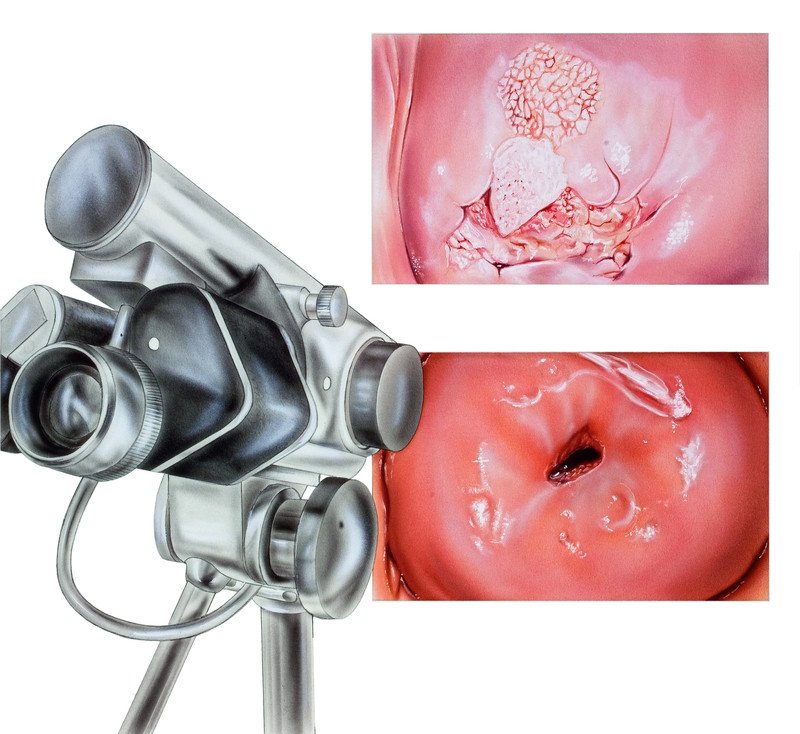Colposcopy
Medically reviewed by Drugs.com. Last updated on Jan 22, 2024.
What is a Colposcopy?

Colposcopy is an examination of a woman's vagina and cervix using a colposcope, a portable instrument with a light source and magnifying lenses. This instrument lets your doctor examine the cervix and vagina for cancer and abnormal areas that may become cancer. Colposcopy takes about 15 to 30 minutes and doesn't require anesthesia.
What It's Used For
Doctors use colposcopy to check for cervical cancer or precancerous changes after an abnormal Pap test or as a follow-up procedure to view an abnormal area seen during an earlier gynecological examination. During colposcopy, your doctor can remove a sample of tissue from the cervix for testing (biopsy).
|
|
Preparation
You don't have to do anything special to prepare for colposcopy, except that your doctor may ask you not to take aspirin for a week before the procedure. Don't douche or use vaginal creams or medications the day before the procedure. However, because you will need to remove your clothing from the waist down, consider wearing a two-piece outfit with slacks or a skirt. Also, because you may have some mild vaginal bleeding in case the doctor performs a biopsy, bring a sanitary napkin to wear after the procedure.
Be sure to tell your doctor about all of the medications that you take. It is also very important to let your doctor know if you may be pregnant. Do not stop using birth control prior to the procedure.
Because heavy menstrual bleeding may make it difficult for your doctor to see inside the vagina, plan your procedure for a time other than your monthly period.
How It's Done
You will need to remove your clothing from the waist down. You will be given a cloth to cover your waist and legs. You will lie on your back on an examination table with your legs spread, your knees bent, and your heels placed in two stirrups. Your doctor will insert a lubricated instrument called a speculum into your vagina. This holds the vaginal walls open for colposcopy.
|
|
Next, your doctor will look through the colposcope to examine your cervix and vagina. After examining the cervix with the scope, your doctor will use a cotton swab to dab a solution containing acetic acid (similar to white vinegar) onto your cervix to make abnormal areas easier to see. Occasionally, he or she may use the colposcope to take photographs for your permanent medical record.
If necessary, your doctor will remove a small piece of tissue (biopsy) from any suspicious area. Your doctor may use a local anesthetic to numb the biopsy area. The biopsy procedure may trigger some brief mild cramping or a little discomfort. Some doctors encourage their patients to take a mild pain reliever such as ibuprofen (Advil, Motrin and other brand names) before the procedure to reduce any discomfort.
|
|
Any tissue removed during the procedure is sent to a specialist (pathologist) for examination under a microscope. The pathologist will notify your doctor if any cancerous or precancerous changes are discovered.
Follow-Up
You can return to normal daily activities right away. Check with your doctor about any restrictions concerning sexual intercourse.
If you had a biopsy, you may have mild vaginal bleeding but should have little or no pain. Call your doctor for your results in a few days. Keep in mind that additional treatment will be needed if anything abnormal is found during the colposcopy.
Risks
Although there is a very small risk of infection or heavy bleeding if a biopsy is performed, colposcopy is generally a safe and painless procedure.
When To Call a Professional
Call your doctor immediately if vaginal bleeding becomes heavy. Call your doctor if you have abdominal pain or discomfort, fever or a discolored or foul-smelling vaginal discharge.
Additional Info
American College of Obstetricians and Gynecologists
http://www.acog.org/
Further information
Always consult your healthcare provider to ensure the information displayed on this page applies to your personal circumstances.



